The HP S700 And S700 Pro SSD Review
by Billy Tallis on September 7, 2017 9:00 AM ESTRandom Read Performance
Our first test of random read performance uses very short bursts of operations issued one at a time with no queuing. The drives are given enough idle time between bursts to yield an overall duty cycle of 20%, so thermal throttling is impossible. Each burst consists of a total of 32MB of 4kB random reads, from a 16GB span of the disk. The total data read is 1GB.

The HP S700 Pro's QD1 burst random read performance is a bit slower than the ADATA SU800 except for the 128GB capacity, but overall the scores are fine for a budget SSD. The S700s all perform similarly and slightly ahead of Toshiba's OCZ VX500 (DRAMless with MLC) and the 128GB SU800.
Our sustained random read performance is similar to the random read test from our 2015 test suite: queue depths from 1 to 32 are tested, and the average performance and power efficiency across QD1, QD2 and QD4 are reported as the primary scores. Each queue depth is tested for one minute or 32GB of data transferred, whichever is shorter. After each queue depth is tested, the drive is given up to one minute to cool off so that the higher queue depths are unlikely to be affected by accumulated heat build-up. The individual read operations are again 4kB, and cover a 64GB span of the drive.
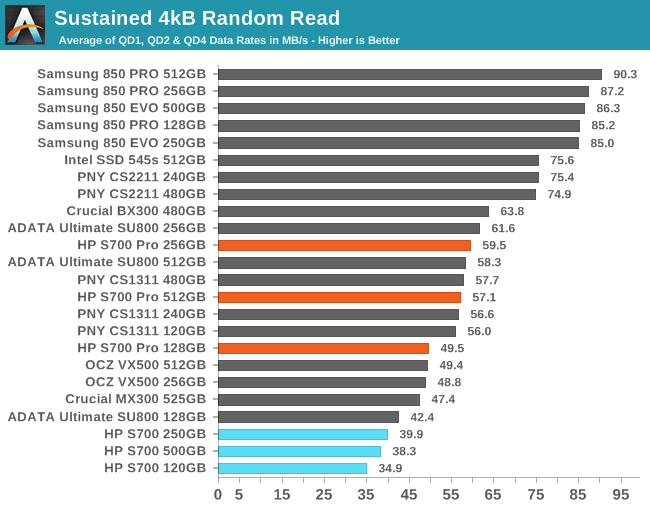
On a longer test and with some higher queue depths, the HP S700 falls to last place, as expected of a DRAMless SSD. The larger two S700 Pros again come in just behind the SU800, while the 128GB S700 Pro beats the SU800 but doesn't match the planar TLC based PNY CS1311.
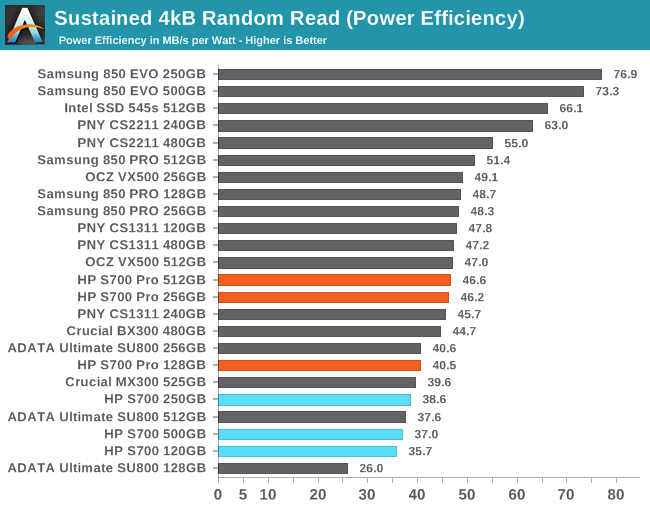
The power efficiency of the S700 is poor but they're not alone at the bottom of the chart. The larger two S700 Pros are about average.
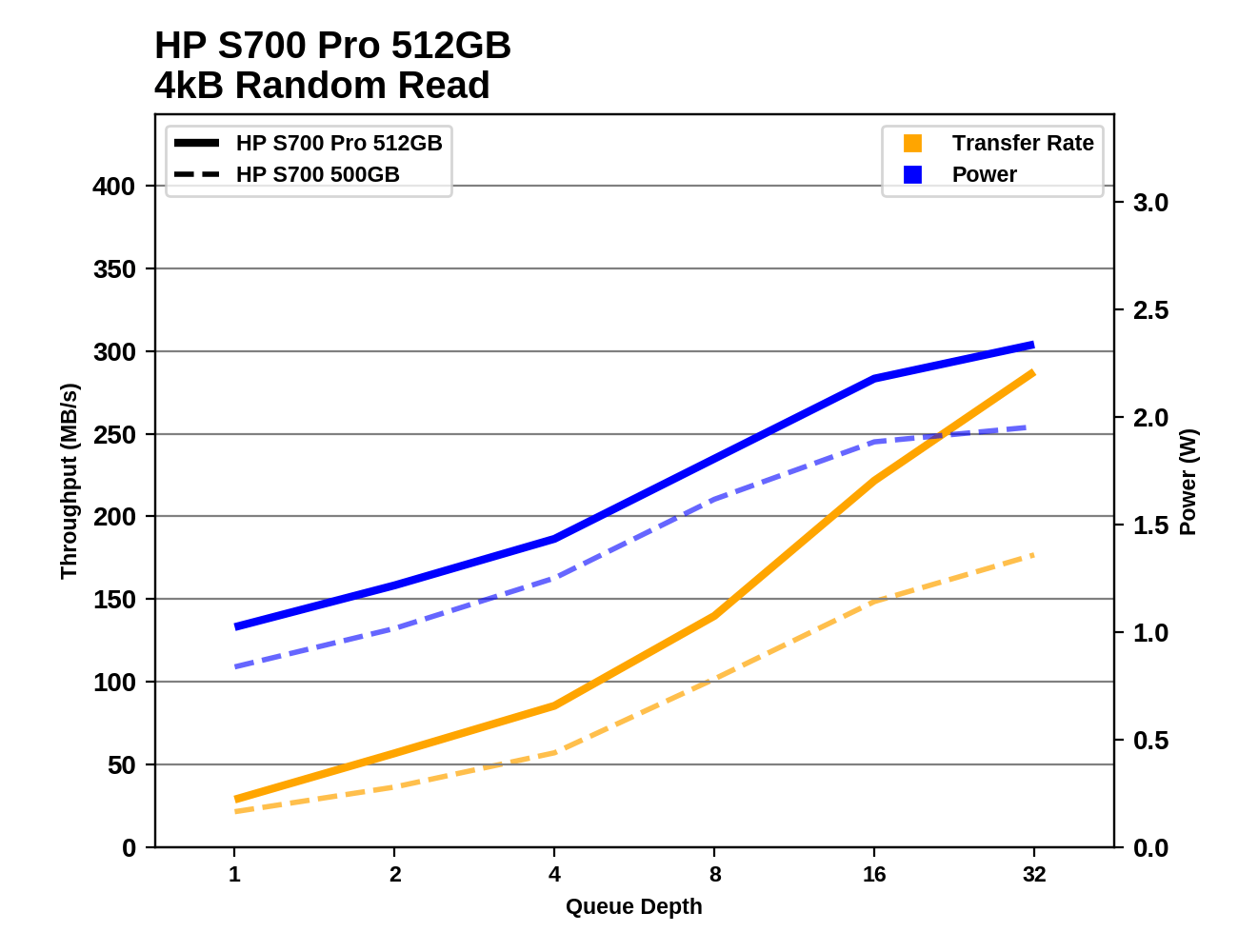 |
|||||||||
The 120/128GB HP drives saturate around QD8, while the 250/256GB HPs show a little bit of performance improvement beyond QD16 and the 500/512GB HPs are still scaling up at the QD32 limit imposed by the SATA link. Unfortunately, none of them come close to the SATA throughput limit even at QD32.
Random Write Performance
Our test of random write burst performance is structured similarly to the random read burst test, but each burst is only 4MB and the total test length is 128MB. The 4kB random write operations are distributed over a 16GB span of the drive, and the operations are issued one at a time with no queuing.
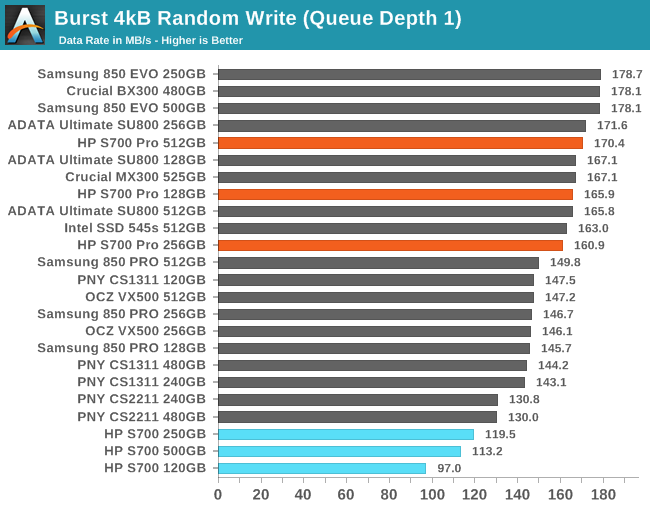
The burst random write performance of the HP S700 Pro is above average at all capacities. The S700 is slowest, but even the 120GB is still more than half as fast as the fastest drive in this bunch.
As with the sustained random read test, our sustained 4kB random write test runs for up to one minute or 32GB per queue depth, covering a 64GB span of the drive and giving the drive up to 1 minute of idle time between queue depths to allow for write caches to be flushed and for the drive to cool down.
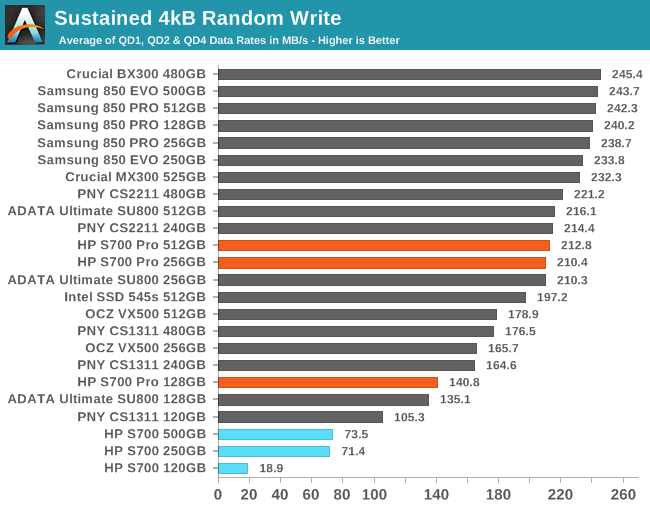
On the longer random write test, the larger two HP S700 Pros maintain average performance while the smallest is at quite a disadvantage, but it's still faster than any other recent 128GB-class SATA SSD. (The 128GB Samsung 850 PRO is very fast, but was discontinued when Samsung migrated to 48-layer 3D NAND.) The 120GB S700 is extremely slow on this sustained test.
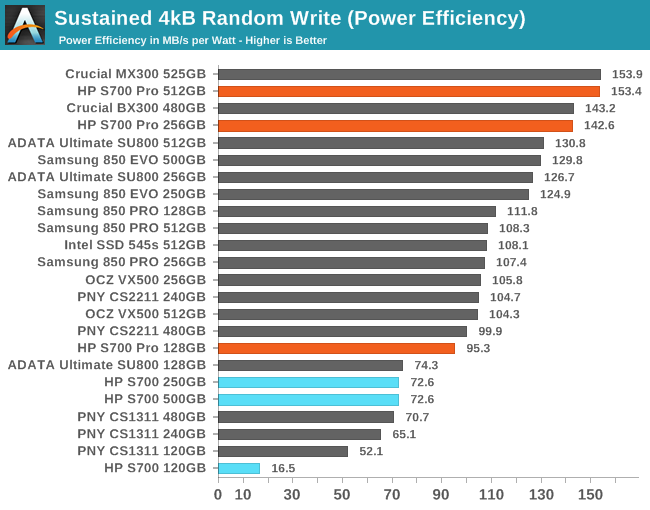
The larger two S700 Pros that offer decent performance also offer great power efficiency, and the smallest S700 Pro is great for its capacity class. The larger two S700s beat the planar TLC drive on efficiency but are otherwise unimpressive, and the 120GB S700's efficiency is little more than a tenth of the best SATA SSDs.
 |
|||||||||
The 512GB S700 Pro's performance scales well from QD1 to QD4, then increases slowly through the rest of the test. The smaller capacities hit the limits of their SLC caches before the end of the test and performance gets much lower and less consistent. The S700s are slow and inefficient throughout the test, but do at least offer the lowest power consumption in absolute terms, hovering just above 1W.










54 Comments
View All Comments
ddriver - Thursday, September 7, 2017 - link
Why is it "Pro"? Performance - nope, endurance - nope, warranty - nope, sounds better - nailed it.HP's brand new Pro bested by Samsung's ancient Evo...
MajGenRelativity - Thursday, September 7, 2017 - link
It's better than the 700 non-Pro, so it warrants that in relation to its other counterpart.mooninite - Thursday, September 7, 2017 - link
You nailed it. Unfortunately HP will sell units because 1) they'll ship them in their own systems they sell and 2) they have blindly loyal customers.MajGenRelativity - Thursday, September 7, 2017 - link
I assume that's why HP went to the trouble of making an SSD? :Psyxbit - Thursday, September 7, 2017 - link
Making? They're not making anything here. They're repackaging another company's engineering efforts.Samus - Thursday, September 7, 2017 - link
The only blindly loyal customers out there are Lenovo's. On the whole, HP's mid-high end systems are the best on the market. Both companies...all companies, make crap at the low end. The business and professional market are where HP just destroys Lenovo is serviceability, reliability, and support. Lenovo simply wins on price. That's why people love them. Because they are cheap. And orange.sonny73n - Friday, September 8, 2017 - link
You sound spiteful. Are you hurt because Lenovo took over as the world's top ranking PC manufacturer after Q2 2013? HP has only gone downhill after that because all HP products have been made in China since who knows when.There's no company I dislike more than a domestic one with products being made overseas then shipped back and sold at home.
barleyguy - Friday, September 8, 2017 - link
You can't have your cake and eat it too. The reality is that western labor costs about 10 times as much as Chinese labor, and it's a price competitive market. If an HP laptop was built domestically, it would cost hundreds of dollars more, and most people would buy the cheaper one built in China.You either get cheap electronics or you get domestic manufacturing. At this point in time, you can't have both.
FunBunny2 - Friday, September 8, 2017 - link
-- The reality is that western labor costs about 10 times as much as Chinese laborthat made a bunch of difference years ago, but if you look at the FRED data, labor has become a vanishingly small part of production cost. if you're relying on bleeding labor to make money, you won't make much money.
Alexvrb - Sunday, September 10, 2017 - link
Exactly. Also there are lots of regions of the US where labor is cheap (rural low cost of living parts of RTW states for example). I suspect other factors such as taxes and regulation drive them to move production overseas more so than the hourly rate of workers.